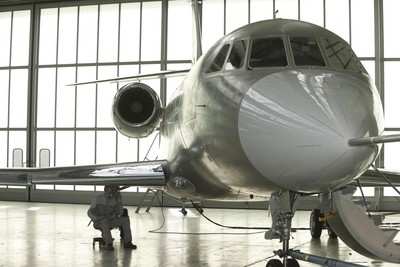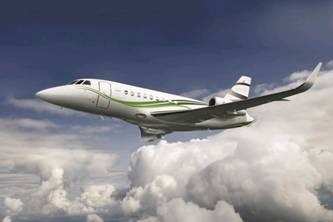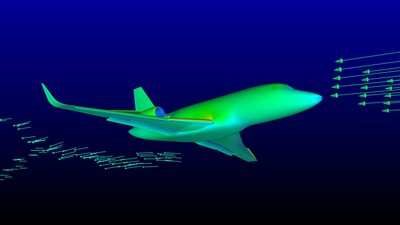Large Cabin Jet For The Super Mid-Size Market
Dassault Falcon launched the Falcon 2000S Monday, bringing a
large cabin aircraft to the super mid-sized business jet market.
The 3,350 nm Falcon 2000S will feature inboard slats, high-Mach
blended winglets, a new generation PW308C engine that produces
fewer emissions, an entirely new BMW Group DesignworksUSA interior
and redesigned cockpit aesthetics along with the next-generation
EASy II flight deck. It is expected to be certified in the end of
2012 with deliveries beginning in early 2013.

“After speaking with our customers and performing a
thorough market study, our research confirmed that the ideal
platform for a wide-body business jet in this range segment was
indeed our very successful Falcon 2000,” said John
Rosanvallon, President and CEO of Dassault Falcon. “We
optimized the platform with a long list of standard options,
cutting edge technology and industry leading features with the
Falcon 2000S. Our proudest accomplishment, though, was designing an
aircraft that burns 10% less fuel than aircraft 20% smaller while
offering a very competitive price.”
With full fuel, the Falcon 2000S will have the largest payload
in its class at 1,850 lbs; a maximum takeoff weight (MTOW) of
41,000 lbs with a balanced field length of 4,450 feet which is up
to 500 feet less than competing aircraft. At M.80, the Falcon 2000S
will have a range of 3,350 nm (standard aircraft, 6 passengers,
NBAA IFR reserves, 85% Boeing Annual Winds). It will climb directly
to 41,000 feet in 19 minutes, reach a mid-cruise altitude of 45,000
feet and offer a certified ceiling of 47,000 feet. The aircraft
will also be able to land at 95% of its MTOW, or about 39,300 lbs
enabling it to tanker more fuel. Additionally, with an approach
speed of only 108 knots and an advanced autobraking system, the
Falcon 2000S will be capable of landing at airports with
challenging and steep approaches and shorter runways such as London
City Airport. At a typical end-of-flight profile, the Falcon 2000S
will need just 2,600 feet of runway, or the equivalent length
needed for a typical turboprop aircraft.

“The impressive performance characteristics of the Falcon
2000S are matched by the value it brings to the operator. By
building on the Falcon 2000 platform, we were able to substantially
reduce development costs which will benefit our customers with a
very competitive acquisition price,” said Rosanvallon.
“Not only is the cabin taller, wider and more elegant than
competing aircraft, it will come equipped with a comprehensive list
of standard equipment.”
The Falcon 2000S will be delivered standard with EASy II in the
cockpit. Updated, Greener Engine Thrust on the 2000S is provided by
two Pratt & Whitney 308C engines proven on the Falcon 2000EX/LX
which will provide 7,000 lbs max thrust each at ISA+15°C.
However, the newest generation of this engine is even more
environmentally friendly due to a new TALON II combustor. It
reportedly produces 20% fewer NOx emissions than the previous
generation, without any penalty in power. It will also reportedly
be 40% greener than required by the CAEP/6 regulations being
planned for future implementation.

The 2000S is available in a standard floor plan with seating for
ten passengers. It will be delivered standard with a new Rockwell
Collins Cabin Management System that places more controls and
convenience into the hands of its passengers making the transition
from the office to the aircraft as seamless as possible. In
addition to saving weight, the new system will provide high
definition viewing for Blu-ray media on wide-screen monitors of up
to 19 inches. Functions can be controlled anywhere in the aircraft
via an iPod Touch or iPhone with a special application that allows
control of video playback, operation of the optional electronic
window shades and adjustments to lights and temperature, among
others. The AirCell Axxess II Satcom System will be included as a
standard feature.
The first Falcon 2000S flew on February 17, 2011 in
Mérignac, France. Since that time, 40 flights have been
flown with 100 flight hours accumulated. The test campaign is
expected to conduct 500 flight hours before certification.
 NTSB Final Report: Dehavilland DHC-2 MK 1
NTSB Final Report: Dehavilland DHC-2 MK 1 Aero-News: Quote of the Day (10.29.25)
Aero-News: Quote of the Day (10.29.25) ANN's Daily Aero-Linx (10.29.25)
ANN's Daily Aero-Linx (10.29.25) ANN's Daily Aero-Term (10.30.25): Minimum Friction Level
ANN's Daily Aero-Term (10.30.25): Minimum Friction Level ANN's Daily Aero-Linx (10.30.25)
ANN's Daily Aero-Linx (10.30.25)





